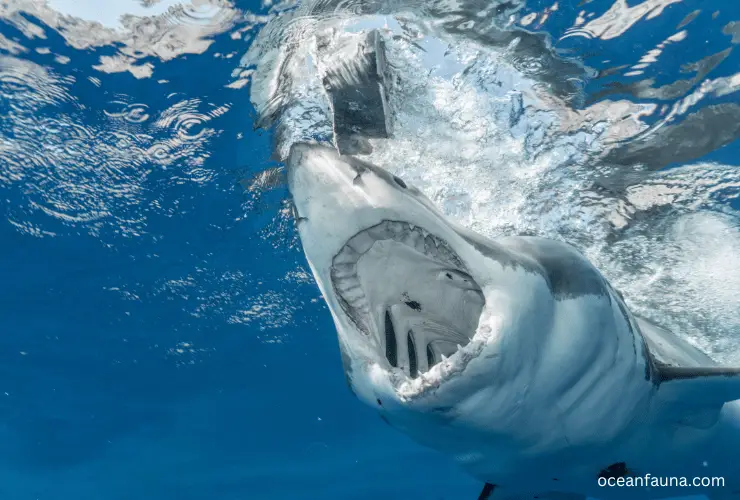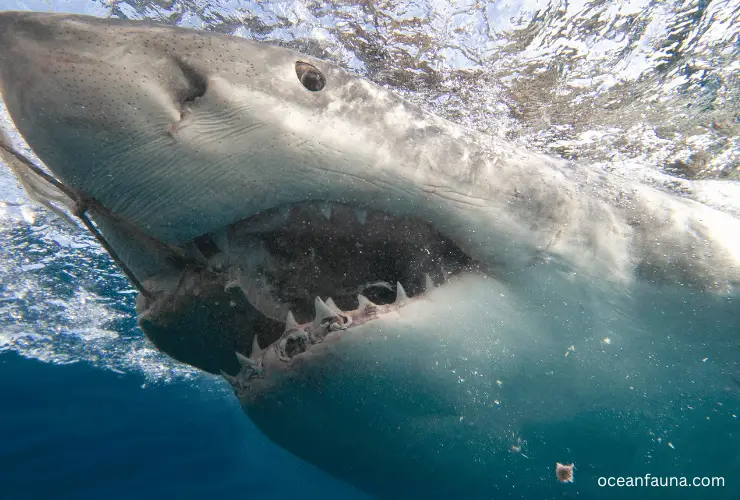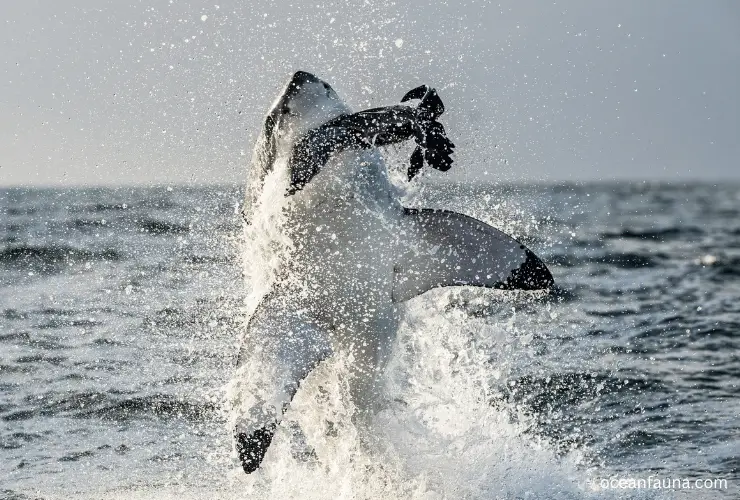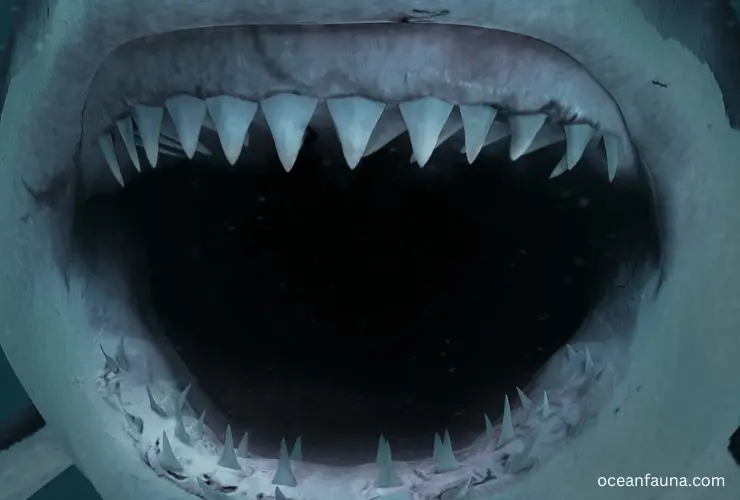No, sharks do not chew their food like humans. Instead, they just tear off large pieces and gulp them down.
Now you may ask why sharks don’t chew their food when they have razor-sharp teeth. Here, I will disclose everything in detail in this article. You just have to stick with the article till the end. Let’s dive in.
Do Sharks Chew Their Food?
Sharks don’t chew their food. They use their teeth to rip off large pieces of food and then swallow them whole.
Sharks have triangle-shaped teeth that help them tear apart their food and hold it tightly while they eat. These serrated teeth can slice through flesh easily, allowing the shark to quickly rip off a large piece of meat before gulping it down.
Sharks don’t have molars like humans do, which would break down food by grinding or crushing it. This means that sharks don’t need to chew their food in order to digest it.
Because of this, sharks can eat much larger pieces of food than others can. Some species can even swallow whole fish or sea turtles.
Why Don’t Sharks Chew Their Food?
Sharks don’t chew their food because they have no need to grind or crush their food for digestion. Sharks are equipped with specialized teeth that allow them to grab and hold prey and rip it apart. This is why sharks can swallow their prey without breaking it down first.

Unlike humans, sharks lack the jaw muscles necessary for chewing and grinding food. They also don’t have molar teeth, which are specially designed for breaking down and crushing food particles into edible pieces.
Additionally, some sharks have a row of replaceable teeth that can rotate into place when one is lost, which allows them to maintain their ability to feed even if they suffer tooth damage. This design is optimized for a predatory lifestyle that involves biting and tearing rather than chewing.
Sharks also have an advantage when it comes to digesting their prey quickly since they don’t need to spend extra time breaking down their meal into smaller pieces. This allows them access to more nutrition from the same amount of food than if they had chewed it up first.
How Do Sharks Eat Their Food?
Sharks have an array of jagged teeth, which allow them to rip their food into pieces in order to consume it, thus removing the need for chewing. Because of this, sharks can swallow entire prey without ever needing to take a bite out of it.
However, some species of shark may use a different method of feeding. For example, Port Jackson sharks (Heterodontus portusjacksoni) probably grind their food with flat teeth in the back of their mouths before swallowing.
Another way that sharks may consume their food is through filter feeding. This involves filtering large amounts of water through the gills and using specially adapted structures such as gill rakers to capture prey particles from the water column. Filter feeding typically occurs with planktonic organisms like krill or small schooling fishes.

Sharks like whale sharks (Rhincodon typus) and basking sharks (Cetorhinus maximus) take advantage of this method and are able to filter prey from huge volumes of water quickly, making it an efficient strategy for consuming large amounts of food.
In addition to traditional methods of consumption, some species also employ suction feeding. In this technique, they generate a powerful jet-like motion by rapidly expanding their pharynx, which draws prey into their mouths.
Suction feeding is common among active predators such as mako sharks (Isurus oxyrinchus) and great white sharks (Carcharodon carcharias). It allows them to catch fast-moving prey with relatively little effort and has enabled them to become top predators in many marine ecosystems around the world.
How Do Sharks Digest Their Food?
Sharks pursue a twofold digestion strategy: mechanical and chemical.
Mechanical digestion initially starts in the sharp-toothed mouth, where prey is ripped off with one bite and swallowed whole. This process exponentially increases enzyme access to surface areas during chemical digestion.
Subsequently, the stomach carries out the chemical breakdown of food particles that have already been reduced in size by mechanical processes such as tearing meals.
Sharks have very acidic stomachs that contain powerful digestive enzymes capable of breaking down proteins, fats, carbohydrates, and other molecules found in food.
Also Read: Are There Any Venomous Sharks?
After the food is broken down into small particles, it moves from the stomach to the intestines for further absorption of nutrients by specialized cells lining the inner walls of these organs.
Sharks also possess an additional organ known as a spiral valve that contains several twists and turns that increase surface area and slow the movement of food through the intestine. This allows sharks to absorb more nutrients from their meals before they are excreted through feces.
Do Sharks Use Their Teeth to Chew?
Sharks do not use their teeth to chew their food. Their teeth are designed for hunting and catching prey, not for chewing. Unlike humans, who have molars and incisors for biting and chewing, sharks have sharp, serrated teeth that are adapted for cutting and tearing.
When a shark catches its prey, it uses its teeth to grab and hold the victim in place. The sharp teeth then work on ripping the prey into smaller, more manageable pieces. These pieces are then swallowed whole without any chewing.
Which Shark Has the Strongest Bite?
Based on the research done by biologists, it is clear that the bull shark has the strongest bite among sharks. Not only does it possess a larger jaw size than great white sharks and hammerheads, but pound-for-pound, its bite force is greater than that of either of these species.

The force generated by an adult 9-foot-long bull shark’s bite was reported to be 478 pounds, whereas an 8-foot-long great white shark’s bite generated 360 pounds of force. A pound-for-pound comparison indicates that the bull shark has a significantly higher amount of bite force compared to other species.
On top of this, the bull shark’s jaws are equipped with triangular serrated teeth, which allow them to hold onto their prey more easily and prevent escape.
Furthermore, the muscles associated with its jaw are much better developed than those in other species, making it even more powerful when biting down. This combination of attributes means that bull sharks can effectively clamp down on their prey without expending a large amount of energy.
Given how formidable its bite is, it’s no wonder why bull sharks have been observed hunting in both fresh and saltwater habitats and preying on a variety of large animals such as dolphins and turtles.
Also, their ability to survive in both types of waters makes them one of the most widely distributed predators across various marine environments around the world today.
All things considered, while there may be some variations in terms of absolute strength between different species, scientists have concluded that bull sharks possess the strongest bite among all sharks, pound for pound.
This is due to their larger jaw size and highly developed jaw muscles combined with sharp serrated teeth, making them highly effective hunters capable of clamping down on virtually any prey they come across with considerable force.
Conclusion
Hopefully, all your confusion is solved now that sharks chew their food. They lack any chewing teeth and are equipped with a robust digestive system to break down larger portions of food.


1 thought on “Do Sharks Chew Their Food? [Interesting!]”